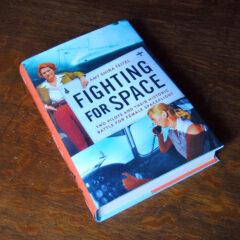
Amy Shira Teitel’s Fighting for Space: Two Pilots and Their Historic Battle for Female Spaceflight features two characters who, while separated by 25 years in age, both lead the way for Sally Ride, but it wasn’t a smooth flight.
It’s compelling in the most dramatic of ways, and not just because the space program NASA had at the start consisted of “a bunch of rockets with a tendency to explode.” And despite a rallying cry of wanting the first woman in space to be American, it was Valentina Tereshkova from the Soviet Union who got there first.
That didn’t stop the race, it just changed it. And while neither of the book’s major characters Jackie Cochran nor Jerrie Cobb got to sit atop a rocket, their contributions to the battle for gender equality within the cockpit or capsule are worth your time.
The story starts with Jackie Cochran; one of the most decorated pilots in American history, the first woman to break the Sound barrier, and a fierce proponent of female empowerment in aviation. All of her records, all of her exploits, and all of her prominent connections in and around military and Washington brass is all documented, so that when Jerrie Cobb, the story’s other lead character enters the fray chronologically, we have a groundwork laid for not only what Cochran has tried to establish as a trailblazer, but the context of norms of the era.
Teitel writes in the book’s preamble that “In the interest of exploring every avenue, I spent the better part of four years researching not only these women and the players who shaped their stories, but the media’s portrayal of women pilots, domestic and international politics, as well as the evolution of flight, spaceflight, and women’s rights.” This not only adds details to the story but adds relevance and weight to the story as it unfolds.

Author Amy Shira Teitel
Jerrie Cobb’s story also starts at the beginning, though she is 25 years behind Cochran, it isn’t the age difference that separates these two, it’s an outlook that Teitel does well to not only illuminate but to explain.
And there’s a general history lesson to make sure you are put in the right time and space. Do you know about the Mercury 13? The Women’s Auxiliary Service Pilots? That Chuck Yeager taught Jackie Cochran before her supersonic flight? You’ll learn all of this and much more.
This book is edge of your seat thrilling and a lot of that detail comes from Teitel’s research, but she did a great job making sure that where possible she used quotes. Also, during the preamble Teitel explains what she wants the reader to get from consuming the book:
“I want you to marvel at Jackie’s daring, get swept up in Jerrie’s romance, feel the excitement of a record-breaking flight, and experience the excruciating frustration of a dream slipping away. All the women in this story are like the screen heroines of the 1930s and 1940s. They are not defined by “womanhood.” They are pilots and identified as such. They are flyers as well as wives, mothers, and businesswomen. They are incredible, multifaceted people trying to eke out their place in aviation and space while navigating love, family, and friendship, always without compromising who they are.”
Well, Amy, mission accomplished.